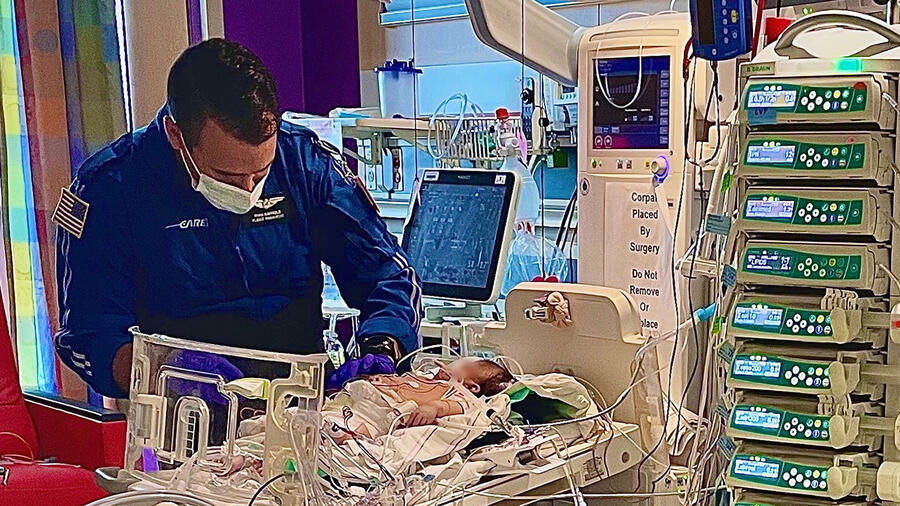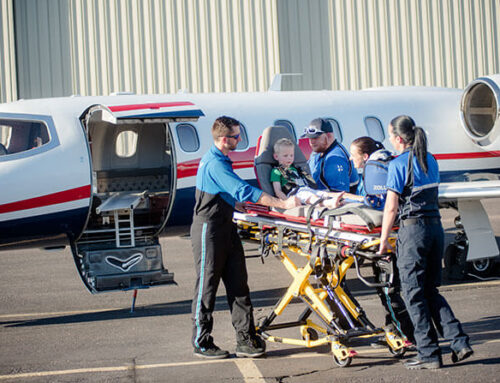Since the advent of the air ambulance and its eventual evolution into long-range, intensive care units in the sky, its highly trained flight teams are responding to young patients that are more complex than ever before.
AirCARE1 was called to transport a critically ill, pre-term, three-month-old infant with a multitude of congenital defects requiring comprehensive pulmonary and advanced cardiovascular life sustaining measures. The baby was to be transferred from an Intensive Care Unit at Phoenix Children’s Hospital to an
Intensive Care Unit at Texas Children’s Hospital for evaluation by a physician specialising in patients just like this one, and one last chance at survival. During each stage of the transfer, she would receive highly specialised treatment from our advanced clinical team.
Preparation
To adequately prepare for an undertaking of this magnitude, AirCARE1’s Communications Specialists obtained detailed information from the sending facility, while a member of the clinical team obtained detailed reports from both hospitals. AirCARE1 implemented its own risk assessment metrics in the form of an ‘Operational Risk Management’ Tool and determined that to better facilitate this particular mission they would need additional flight crew members to ensure adequate care was administered during all phases of the flight. AirCARE1 designated the appropriate team dynamic and prepared specialised equipment, such as a portable aviation device designed to safely transport an infant called a ‘Baby Pod’, supplementary medication infusion pumps, a mechanical ventilator, and a monitor capable of atrioventricular pacing.
Finally, after thorough evaluation, the team addressed each safety concern with all parties involved. Having several conferences with the patient’s family, the risks of the transfer were clearly presented, up to and including the possibility that this child might not make it to the receiving hospital alive. AirCARE1 received signed consent, and the mission was underway!
Transport
Once the AirCARE1 clinical team arrived at the patient’s bedside, the meticulous process of packaging and transferring the patient to AirCARE1’s ‘Baby Pod’ was initiated. The patient was on 14 different intravenous infusions, including analgesia, sedation, paralysis, diuresis, electrolyte replacement and many cardiac and vasoactive medications, all the while mechanically ventilated, epicardially paced and haemodynamically monitored.
Moving a patient with the amount of life-saving equipment required to keep this child alive presented challenges that were easily remedied by having extra sets of hands during each phase of the nearly nine-hour call. AirCARE1 had two flight nurses manage the infusions, and one flight paramedic dedicated to ventilator management and electrocardiographic and haemodynamic monitoring. With an augmented team to ensure adequate patient monitoring and continued assessment, and no shortage of ancillary team members to assist each time the patient was moved, AirCARE1 was able to come together and safely and effectively transport the patient nearly 1,200 miles away.
Summary
During the duration of the patient’s transport with AirCARE1, the patient received the highest level of care the air medical industry can offer. Through a focus on continual education, mission pre-planning, and flight-specific preparation, all aspects of this patient’s flight were thoroughly calculated and skillfully executed by AirCARE1’s team of medical professionals. With no signs of significant clinical deterioration in the infant’s condition, she was delivered to the receiving hospital where a full report of her vitality and transfer of her medical devices, monitoring equipment, and in-flight treatments concluded her time with our team. AirCARE1’s processes in preparation of these complexities have shown to greatly improve the outcomes of our patients, and will continue to present efficacy now, and well into the future.
Click here to read the original article on ITIJ.
Contact our team today if you need similar services or to learn more about our neonate services.




